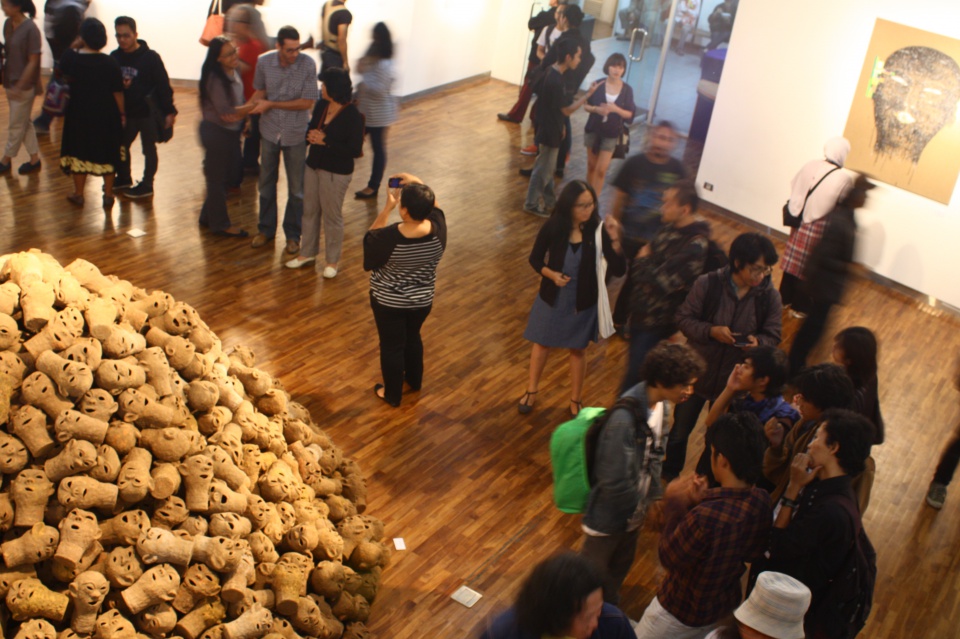The generation of artists rising after Reformasi is failing to create meaning outside the art market
Aminudin TH Siregar
 ‘Seeing Java’, an exhibition of work by Dadang Christanto, was one of the events held at the Soemardja gallery in 2012 – Aminudin TH Siregar
‘Seeing Java’, an exhibition of work by Dadang Christanto, was one of the events held at the Soemardja gallery in 2012 – Aminudin TH Siregar
Contemporary art practice in Indonesia is displaying a new complexity. As a result of the social and political transformations that have come with Reformasi since 1998, artists have had to show unprecedented sensitivity about their positioning within the art world, as opposed to orienting their work to projects located outside of that world. This sensitivity reflects a new environment for artistic production.
Indonesian art practice has left behind the period of unity it displayed just over a decade ago, when the avant-garde spoke up for the interests of the masses with ideological commitment. It is now in acceleration mode, with the last two years featuring innumerable exhibitions in comparison with the preceding years. This acceleration has brought disorderliness: nowadays, the art world appears to be overflowing. But ironically, the unceasing and rapid change we are experiencing in everyday life brings with it also a sense of boredom, or a sense that amidst all this activity, nothing is being achieved.
Such boredom was not possible in the days when art was a medium of rebellion. We now live in an era of open-mindedness, in a more democratic environment for artistic production. We have moved from an atmosphere in which ‘everything is prohibited’, like it was under the authoritarian rule of Suharto, to one in which ‘everything is allowed’.
Everything is allowed
The credo ‘everything is allowed’ emerged in the 1990s with the blossoming in Indonesia and elsewhere of the postmodernist paradigm, meaning art was open to a plurality of styles and references, and relished the exploration of its own mediatedness. Indonesian postmodernism, which is now identical with contemporary art in Indonesia, had its starting point in the Ninth Jakarta Biennale of 1993-1994.
But this postmodernist credo has become a boomerang, coming back to us with a revised message: ‘everything is prohibited’. What is this new prohibition? It is a sociological effect created by a novel class of artists, dealers and galleries. These form the new tyranny. Yesterday’s novel credo (postmodernism) has become a ‘new packaging’ that forces freedom of expression into a new captivity. Forms of artistic expression not supported by this novel class fall at the margins. In other words, too many points (postmodernism) have made the point itself (modernism) disappear, even before the point itself had been able to replace a starting point that has also disappeared (Indonesia’s creative heritages).
The credo of ‘everything is allowed’ exposes a new borderlessness: the shining façade of popular culture is its main actor; convention has disappeared; pastiche, kitsch and eclecticism have emerged as dominant spirits; many aesthetic rallying points vie against each other, including hyperrealist art, allegorical art, and realist photography; art history has reached its terminus; meaning and depth vanish; and the conservative paradigm that divided artistic practice into disciplines providing an absolute point of reference has disappeared.
These changes mark our exit from a period when art confronted ideological and spiritual meanings head on, when it referred to something outside itself. We have left traps like myth, tradition, and morals, behind us and now are ditching our dependency for an instrumentalism in which art is just a tool used by an artist to judge the world around him or herself. We have exited from the episode where the ‘function’ of art was highly valued and constantly sought out.
Contemporary Indonesian art reminds us of the fate of ‘modernism’, which eventually failed to fulfill the emancipatory promises that it roared to Indonesians in its pre-independence heyday. Its practitioners praised modernism as the agent that would free humans from the restraint of myths and pagan culture, as well as from the repression of colonialism. In 1938 the Union of Indonesian Artists (Persagi) set itself against the fetid vision of Mooi-Indië (The Beautiful Indies), an aesthetic in which our artists submitted to a colonial version of Indonesian realities. But modern art ended up restraining humans with new myths and pagan idols that were even more repressive, such as the market, elitism, ideological schisms, politicised nationalism, and universalisms that put art at a distance from most Indonesians.
The modernist paradigm has been left behind, superseded by the novelty of postmodern art, but this has also failed to provide better outcomes. This is art that people cannot understand. Contemporary artists appear to have been crowned as the voices for the expression of social pathology and cultural and moral crisis. We are forced to become the subjects of this crown, but we do not understand the allegiance we owe to it. We are forced to endure a new enlightenment in which it is not clear what is replacing what.
The reverse could be observed in the 1990s. Artists like Moelyono, with his conception of ‘awareness’, and Semsar Siahaan with his ‘Art of Liberation’, created art that was ideological, political and obvious. But these paradigms have faded in the 21st century. We have arrived in more complex new ground, and have to deal with the excesses of old paradigms that were never successfully resolved. We confront the era of ‘everything is allowed’ before we have digested the bold statements of Moelyono and Siahaan.
Perversion
The current art scene presents us with multiple perversions: revisions of language, piracy of signs, inversions of norms, breaches of taboo, maskings of meaning. Such practices have become a new normality, caused by the absence of laws or codes. Within the aesthetic of perversion, new art is marked by its capacity to ‘look like something else: this looks classical; this looks critical; this looks aesthetic; this looks social; this looks feminine; this looks masculine, realistic, formalistic. And so on.
The new player to surface from this scene is the market. Indonesian art is now trapped in commodification. But an art that is rooted in the freedom of the market cannot generate any meaningful agenda. Instead, the credo of ‘everything is allowed’ shapes an art that does not hold itself accountable to any social function.
Indonesian contemporary art at the beginning of the new millennium displays an ambivalence rooted in the refusal of artists to deal with major social or other issues. Our contemporary art is flooded with narrations of the miniscule. Of the personal. This is a crucial transition from the eras dominated by S. Sudjojono (1913-1985), Heri Dono (b. 1960) and other formative figures in our art history. In the mid-1990s the Yogyakarta-based ‘Window Group’ of Jumaldi Alfi, Yunizar, Handiwirman, Rudi Mantofani and Yusra Martinus, for example, with its highly personalised explorations of aesthetic forms, overlooked the nation’s social wounds, replacing them with its members’ own ‘personal wounds’. Since then, social catharsis has been replaced with individual catharsis, and the meanings of art are best understood only by the artists themselves.
The ‘boomerang’ of the ‘everything is allowed’ credo has returned to us, bringing back a yearning for consistency, firmness, orderliness, reference, boundaries and conventions. In short, we feel a rising urge to regain the modernist paradigm of innovation, progressiveness, and originality.
This is not to say that the contemporary narrations of the miniscule have not been received with appreciation by the public. Some artists display a keen eye in their explorations of new media and techniques. The efforts of Uji Handoko Eko Saputra (Hahan), Radi Arwinda, Terra Bajraghosa and others have been successful. The international art scene is very ready for Hahan’s naïve critique of the western artocracy, expressed in images sourced from popular culture and underground comics. However, just as the tastes of contemporary music listeners tend towards easy listening, the artists of this new generation no longer seek meaning. They produce easy visualisation: artworks that are merely good to look at.
New tendencies
The contemporary Indonesian art scene tells us that the nationalist project of Persagi and S. Sudjojono in the 1940s is a thing of the past. So is the political artwork of the 1990s. The current generation is open-minded, and also open to the game of signs. We find ourselves enjoying artworks that offer no reference points, because they are saturated with things we have seen before. The furthest boundaries of the possible have been reached. What we see now is games played with pieces of history.
This generation avoids the moral tension that always came with the dreams of the artists who believed they were trying to create an Indonesian identity or rectify social problems. They did not hesitate to occupy the high ground. But the foremost artists of today do not highlight mental decadence, social deprivation, or other society-wide problems. They no longer advocate on behalf of marginalised communities or political causes. They produce no weighty narrations. They prefer lighter stories, superficiality, and personal things. This generation grew up after the freedom of the Reformation era had already arrived. They are building their reputations in borderless captivity.
Aminudin TH Siregar (‘Ucok’) (b. 1973) (blupart@yahoo.com) is an independent curator and the director of the Soemardja Gallery in the Bandung Institute of Technology’s Fine Art Department. He is also a practicing artist and has exhibited widely in Indonesia as well as overseas.











